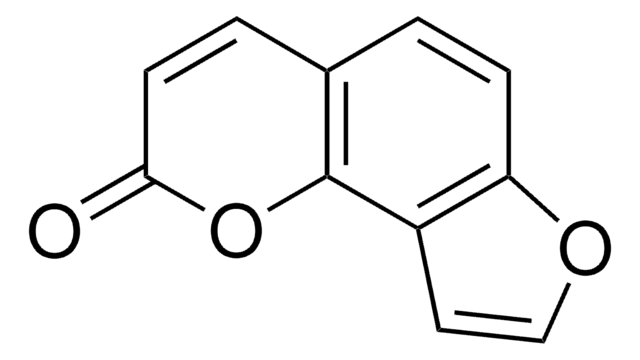P8399
Psoralen
≥99% (HPLC)
Synonym(s):
6,7-Furanocoumarin, 7H-Furo[3,2-g]benzopyran-7-one, Ficusin, Furo[3,2-g]coumarin
Select a Size
Select a Size
About This Item
Recommended Products
Quality Level
assay
≥99% (HPLC)
form
powder
fluorescence
λex 335 nm; λem 460 nm (pH 7.0)
storage temp.
2-8°C
SMILES string
O=C1Oc2cc3occc3cc2C=C1
InChI
1S/C11H6O3/c12-11-2-1-7-5-8-3-4-13-9(8)6-10(7)14-11/h1-6H
InChI key
ZCCUUQDIBDJBTK-UHFFFAOYSA-N
Looking for similar products? Visit Product Comparison Guide
Application
- as a crosslinker for dsRNA for in- situ hybridization studies[1]
- in testing melanin dispersal effects in fish scale melanophores[2]
- to test its stimulatory effects in osteoblast a cell proliferation assay[3]
- as a reference standard in high-performance liquid chromatography (HPLC)[4]
Biochem/physiol Actions
Features and Benefits
signalword
Warning
hcodes
Hazard Classifications
Acute Tox. 4 Oral - Skin Sens. 1
Storage Class
11 - Combustible Solids
wgk_germany
WGK 3
flash_point_f
Not applicable
flash_point_c
Not applicable
ppe
dust mask type N95 (US), Eyeshields, Gloves
Choose from one of the most recent versions:
Certificates of Analysis (COA)
Don't see the Right Version?
If you require a particular version, you can look up a specific certificate by the Lot or Batch number.
Already Own This Product?
Find documentation for the products that you have recently purchased in the Document Library.
Customers Also Viewed
Articles
DNA damage and repair mechanism is vital for maintaining DNA integrity. Damage to cellular DNA is involved in mutagenesis, the development of cancer among others.
Apoptosis regulation involves multiple pathways and molecules for cellular homeostasis.
Cell cycle phases (G1, S, G2, M) regulate cell growth, DNA replication, and division in proliferating cells.
Active Filters
Our team of scientists has experience in all areas of research including Life Science, Material Science, Chemical Synthesis, Chromatography, Analytical and many others.
Contact Technical Service









